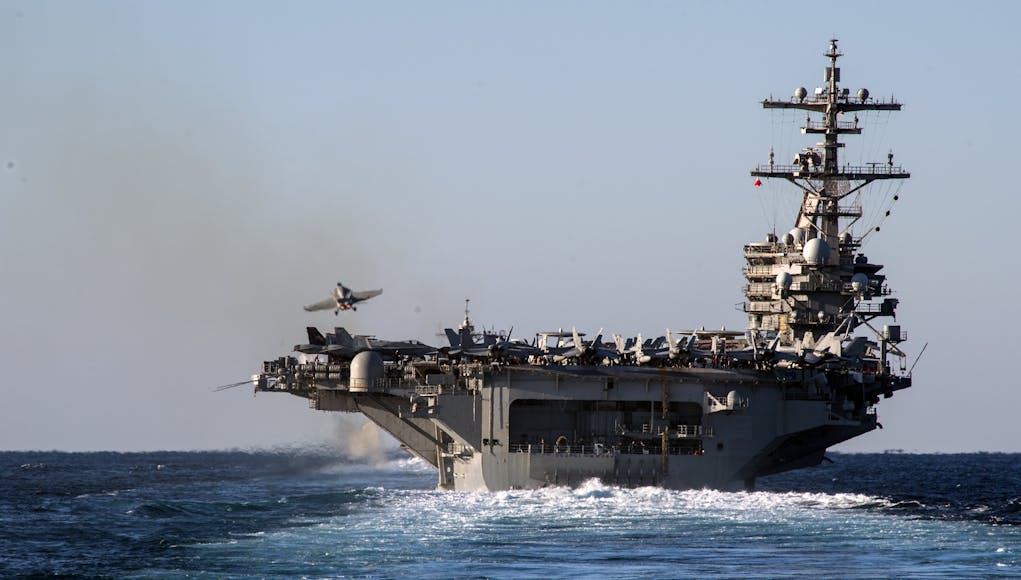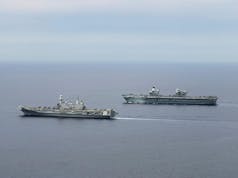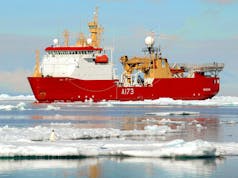Royal Navy officers will embark on the USS George H.W. Bush when she enters UK waters this week for Exercise Saxon Warrior in preparation for the deployment of HMS Queen Elizabeth.
As we reported in January, Saxon Warrior is an exercise designed to develop ‘theatre-specific combat skills’ as well as enhance cooperation between multi-national forces.
Led by Flag Officer Sea Training (FOST), Saxon Warrior presents a ‘myriad of challenges to the multi-national and multi-platform force by creating a diverse and unpredictable war environment based on fictional geo-political and military scenarios’.
Cmdr Eric Retz, US Navy Carrier Strike Group 2’s operations officer, said of the exercise:
“Saxon Warrior will test every aspect of our war-fighting capabilities-from air wing strikes to the self-defenxe of the carrier.
The beauty of operating with coalition partners is that we practice with them, learn their strengths, and then blend those strengths together to make the most potent coalition force possible.”
Trials are simultaneously underway for both HMS Queen Elizabeth and F-35B Lightning before they come together in 2018 but just what do sea trials involve?
Sea trials monitor speed, manoeuvrability, power and propulsion as well as undertaking weapons trials and additional tests on her levels of readiness.
Sea trials were planned beginning in March 2017 but minor technical issues delayed her sea trials until the end of June. Prior to the ship’s departure from Rosyth, an extensive survey was carried out of the Firth of Forth by HMS Gleaner and 42 Regiment, Royal Engineers to gather information on the tides, the depth of the river bed, and the height of the three river crossings (Forth Bridge, Forth Road Bridge, Queensferry Crossing).
Queen Elizabeth sailed on the 26th of June 2017. The first stage of the operation was to move the ship from inside the fitting out basin, via one of the access gates, into the Firth of Forth itself, before taking the ship under the three Forth bridge crossings.
Once this was accomplished, the ship took to the open sea off the east coast of Scotland to undertake the first set of trials, including handling and speed tests. During this period, Queen Elizabeth was accompanied by a pair of Type 23 frigates, HMS Sutherland and HMS Iron Duke, acting as escorts.
The first aircraft to land on the ship was a Merlin HM.2 of 820 Naval Air Squadron on the 3rd July. Following initial runs in and around the Firth of Forth, the carrier was taken further north to the Moray Firth, during which period the ship encountered the Cunard cruise liner Queen Elizabeth.
HMS Queen Elizabeth had her first stopover at Invergordon, where the ship was fuelled and provisioned, and where inspections of the hull were carried out.
Following this initial period, HMS Queen Elizabeth will return to Rosyth for further testing and maintenance before heading back to sea for a second stage which aims to test her Mission Systems. She will transit to her home port of Portsmouth Naval Base to be handed over to the Royal Navy later this year.














You say “a myriad challenges” or “myriads of challenges”, but never “a myriad of challenges”.
Think of “a myriad” as being “ten thousand”.
(you wouldn’t say “ten thousand of challenges”).
You capitalise the first word of a sentence, even if it is in parentheses. Also, if a sentence starts and ends within parentheses, you place the full stop before the closing bracket, not after it.
E.g.
(You wouldn’t say “ten thousand of challenges”.)
What is the operational range and endurance of a fully armed F35B?
I should think it takes significant fuel reserves to land vertically. As far as I know, it can only land vertically.
D. Cuthill – well no. The UK have developed a recovery system called ‘Shipborne Rolling Vertical Landing’ (SRVL) and our hosts here have a video:
https://ukdefencejournal.org.uk/simulation-shows-f-35b-landing-conventionally-new-carriers/
Combat range, obviously, is dependent on the mixture of armament with which the plane is loaded. A good yardstick for the F-35B is 550 nautical miles.
You are correct in assuming that a vertical take-off/ landing consumes enough fuel to affect the range of the F-35B. The US Navy is currently developing its MQ-25 Stingray drone as a refueling tanker. The US Marine Corps plans to deploy these drone tankers above their America class carriers to refuel their F-35Bs immediately after take-off this extending their range. These tankers would also be available to refuel any planes returning from a mission short of fuel.
Buddy Up refuelling was done when we had the first Buccaneers and the US Navy still does it with its F-18s. I am sure the Royal Navy will find a way to keep fuelling their aircraft. One option is to convert the 4 pre-production T & D aircraft to tankers, stripped to a bare minimum and allocated two per ship. After all they will never see combat as they were basically ‘mules’ but are sound airframes
MoD has probably arranged scrappage as we speak
Just so many different aspects coming together piece by piece and all seemingly going well. Be interesting to how the US Navy works with FOST. They don’t respect reputations…
And can’t we just get ONE of the old SHARS from Culdrose up in the air and working with QE before she sails off the the USA?